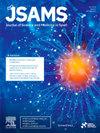Normative percentile values for the TGMD-3 for Italian children aged 3–11 + years
IF 3
2区 医学
Q1 SPORT SCIENCES
引用次数: 0
Abstract
Objectives
Sufficient gross motor skill proficiency is an essential prerequisite for the successful performance of sport-specific skills and physical activities. The Test of Gross Motor Development is the most common tool for assessing motor skills in paediatric populations, however, there is a lack of ‘normative’ data available against which children’s scores can be compared. Normative data would enable the comparison of an individual’s motor development to age-standardised norms. The aim of this study was to develop normative data for the Test of Gross Motor Development Third Edition scores for Italian children.
Design
The Test of Gross Motor Development Third Edition scores from > 17,000 Italian children (aged 3–11 + years) were analysed to develop normative scores and percentiles.
Methods
Total Test of Gross Motor Development Third Edition scores and locomotor and ball skills subscale scores were split by age and sex. Using the LMS method, based on the Box-Cox transformation, percentiles were calculated for each sex-specific age category.
Results
17,026 children were included in the analysis (n = 8262 girls; n = 8766 boys).
Conclusions
This is the largest sample ever used to develop normative data for the Test of Gross Motor Development and the first set of normative data for European children. This normative data can be used to identity insufficient motor skill development and aid subsequent modification of activities to nurture sufficient motor skill proficiency. This is particularly important for children in the lower percentiles given the strong associations between early childhood fundamental motor skill competence and physical activity participation in adolescence and adulthood.
意大利3-11岁以上儿童TGMD-3的标准百分位数。
目标:足够的大动作技能熟练程度是成功完成特定运动技能和体育活动的必要前提。大肌肉运动发展测试是评估儿科人群运动技能的最常用工具,然而,缺乏可用的“规范”数据来比较儿童的分数。规范数据将使个人的运动发展与年龄标准化的规范进行比较。本研究的目的是为意大利儿童大肌肉运动发展测试第三版分数提供规范性数据。设计:分析了bbb17000名意大利儿童(3-11岁以上)的大肌肉运动发展测试第三版分数,以制定标准分数和百分位数。方法:采用大肌肉运动发展量表第三版总分和运动、球类技能分量表得分按年龄、性别进行分型。使用LMS方法,基于Box-Cox变换,计算每个性别特定年龄类别的百分位数。结果:17,026名儿童被纳入分析(n=8262名女孩;n = 8766)。结论:这是迄今为止用于开发大肌肉运动发展测试规范数据的最大样本,也是欧洲儿童的第一套规范数据。这些规范性数据可用于识别运动技能发展不足,并有助于后续活动的修改,以培养足够的运动技能熟练程度。考虑到儿童早期基本运动技能能力与青少年和成年期体育活动参与之间的强烈联系,这对较低百分位数的儿童尤其重要。
本文章由计算机程序翻译,如有差异,请以英文原文为准。
求助全文
约1分钟内获得全文
求助全文
来源期刊
CiteScore
7.40
自引率
10.00%
发文量
198
审稿时长
48 days
期刊介绍:
The Journal of Science and Medicine in Sport is the official journal of Sports Medicine Australia (SMA) and is an an international refereed research publication covering all aspects of sport science and medicine.
The Journal considers for publication Original research and Review papers in the sub-disciplines relating generally to the broad sports medicine and sports science fields: sports medicine, sports injury (including injury epidemiology and injury prevention), physiotherapy, podiatry, physical activity and health, sports science, biomechanics, exercise physiology, motor control and learning, sport and exercise psychology, sports nutrition, public health (as relevant to sport and exercise), and rehabilitation and injury management. Manuscripts with an interdisciplinary perspective with specific applications to sport and exercise and its interaction with health will also be considered.

 求助内容:
求助内容: 应助结果提醒方式:
应助结果提醒方式:


